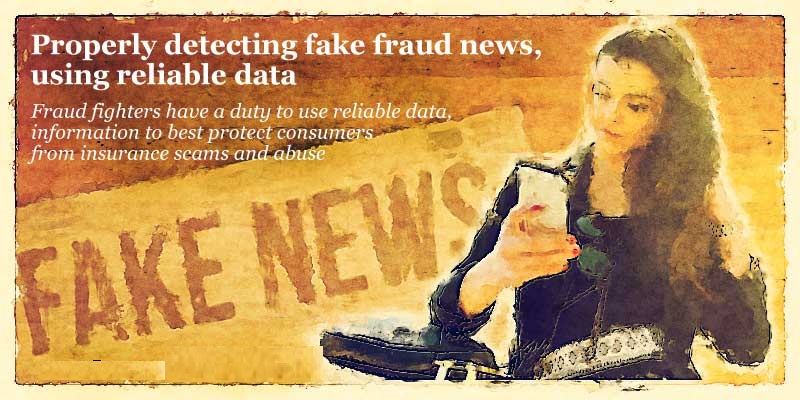
Like or loathe, the term “fake news” is now part of our national culture. Even the venerable Webster’s Merriam Dictionary now includes “fake news.
Fakes, frauds and scams are well-known to the fraud-fighting community. Yet how often do we consider the source of information or data we rely upon in our investigation or advocacy efforts?
As a child I remember my father somewhat cynically stating the adage: “Figures don’t lie, but liars make figures.” We often use data and reports to support our positions and advance our goals. As an attorney, I was taught to cite the law and information if you want to prevail. It remains good advice.
But fraud fighters especially owe a special duty to the public to be cautious about what reports and statistics we cite, and even define what constitutes insurance fraud.
A good case in point recently was discussed among insurance policymakers. The battle has raged for many years over whether insurers have the “right” to use aftermarket versus original (OEM) parts in making vehicle repairs.
Proponents argue that aftermarket parts are at least of equal quality, while critics say insurers use shoddy knockoffs to avoid paying for higher-priced OEM parts. The usually impartial Insurance Institute for Highway Safety recently was embroiled in a battle about the safety of aftermarket parts.
A Dallas law firm is handling a case involving injuries allegedly caused by using aftermarket parts. The firm ran crash tests supposedly showing increased risk of injuries to passengers in vehicles repaired with aftermarket parts. The findings ran counter to tests by others, and referenced by IIHS, which issued a news advisory questioning the validity of the law firm’s findings.
This is one example of how statistics can support far-differing positions on issues affecting insurance overall, and fraud specifically. Leaders such as the Coalition spoke to legislators, often citing studies and data, at the recent NCOIL spring meeting in Atlanta.
One debate showed how “reliable” data can support far-differing views. Of growing national importance are Pharmacy Benefit Managers (PBMs). The “Big 3” PBMs control 78 percent of the prescription drug market, with more than 180 million enrollees. One PBM just made national news by announcing Cigna’s plan to spend $54 billion to take over Express Scripts. Combined, they had revenue of about $142 billion as of last year.
Even before this mega-merger was announced, NCOIL speakers cited statistics, data and pricing analysis to favor and demonize PBMs and their impact on America’s health and prescription drug insurance markets. Statistics were cited to praise and ridicule. Certainly, both sides couldn’t have talked about the same data and “facts” … yet they did. The Coalition was asked if we view PBMs as “insurance fraud.” We’re monitoring the issue, though are carefully researching before taking a stance, if even at all. Why?
First, is the data itself. Today there’s plenty of data on almost any issue. As we consider what constitutes insurance fraud, we seek accurate and verifiable data. Our credibility rests on having good data on which to base a reliable and informed decision. Often that takes time, and willingness to weigh many viewpoints. Having important groups such as NCOIL, NAIC and NCSL as vital parts of the Coalition gives our members an “ear” and “voice” to address these fraud issues on the national stage.
Second, there is a major difference between insurance fraud and abuse. Some practices are disdainful, yet legal, abuses of America’s insurance systems. With hundreds of billions at stake every year, fraud and abuse run rampant. The Coalition uses our 25-year history as a barometer to help decide what to target as fraud versus abuse.
To prove the point, the Coalition recently filed strongly worded comments voicing concern about the Administration’s proposal to authorize Association Health Plans potentially under sole federal control. The Coalition educated federal decisionmakers using our first-hand experience of seeing tens of thousands of consumers defrauded by fake health plans when AHPs ran amuck in 2002-2004. Citing this sorry history, we urged policymakers to allow all-important state oversight of AHPs in conjunction with federal involvement.
Whether the debate is over AHPs, PBMs, OEMs or another string of acronyms, data can support potentially all sides of a debate. We talk about the importance of SIUs deciding whether a claim is fraudulent only when the investigation is complete, with all the facts. We caution younger adjusters to be thorough to avoid allegations of bad faith.
It’s always wise to be certain that data we rely upon is tested and derived from reliable sources. Or does it represent only the views of a special interest group with an agenda? And, is the issue about insurance fraud, or abuse of our insurance system? America’s insurance consumers rely upon carefully weighed opinions and actions by the Coalition, our members and allies as we protect the public from insurance fraud. To that viewpoint, certainly, the Coalition is committed.

Recent Comments